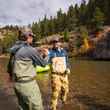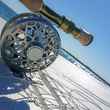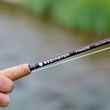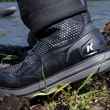Limestone streams, spring creeks, and tailwaters can offer year-round fishing opportunities even in the coldest regions of the country. Die-hard fly fishers embrace freezing temps, numb fingers, and shorter feeding windows on countless streams and rivers located in these colder, northern climes. While I enjoy the beauty of streams and rivers draped by snow-covered backdrops and the peacefulness of streams and rivers devoid of angling pressure, there’s a force that pulls me south each winter. Not south to the tropics, in search of bonefish and permit and such, but to the great trout fisheries of the southern U.S. The southern magnetic pole from which this force emanates isn’t really just one location, but many—man made trout fisheries that dot the American south which offer some of our country’s best trout fishing.
These great southern tailwaters are most commonly, if not exclusively, borne of bottom-release hydroelectric dams which provide cold, reliable flows and highly oxygenated water. Many of these tailwaters occur in regions that otherwise wouldn’t be capable of supporting trout in naturally occurring systems. These dams have transformed many warmwater fisheries into world class trout destinations. While there are countless debates regarding whether these systems are unnatural, as well as over the harmful environmental impacts of hydroelectric dams (especially those that impact fisheries where anadromous species swim—think salmon and steelhead—fisheries which are not the subject of this article), what is not debatable is whether these cold-water releases create excellent trout fishing opportunities.
As noted, many of these world-class fisheries are in the south, where milder winters occur. The average February high/low temperature for my hometown in north central Pennsylvania is 38/19. Now compare that to Bristol, Tennessee (home of the South Holston River) where the February average is 50/29. For me, and no doubt many other anglers, 12 degrees of added warmth creates a far more pleasant angling experience and is one of the primary reasons why I begin thinking about migrating south during the winter. Certainly, many of these southern tailwaters still experience severe winter weather. Frigid temps, snow, and ice storms are all parts of most southern winters, but these events typically occur less frequently and with less severity when compared to the northern states. So if you end up traveling south, “hope for the best but plan for the worst.”
As for what southern tailwater fisheries to target, there’s no one right answer. You’ll need to do a bit of research and decide which destination excites you the most. A quick google search will start laying out your potential southern tailwater targets, and if you choose to dig deeper, there is a long list of books written about fishing southern tailwaters. Some of my personal favorite fisheries include the South Holston, Clinch and Watauga Rivers in the southeast, the White and North Fork Rivers in Arkansas, and the Guadalupe and San Juan Rivers in the southwest. But there are many other options—both popular and not as well known.
Below are a few basic guidelines/suggestions for fishing southern tailwaters. Although every fishery has its own nuances, here are a few tips I wish I knew before I made my first trip south.
Mind the flows
Flows in tailwaters may fluctuate during a day’s fishing. Some of these fluctuations are drastic changes in water velocity and are hazardous to wading anglers. Sudden water releases can make any calm, easily wadeable section of river turn into a torrent of white water in a matter of minutes. Know (when possible) when planned releases will occur. If you’re wading, insure that conditions will remain suitable for wade fishing for the foreseeable future. If a region has experienced significant rainfall, continuous water releases can be scheduled and/or occur for days/weeks at a time—possibly leaving no opportunities to fish on foot.
Note: The Tennessee Valley Authority (TVA) provides information regarding release times. Although information is usually accurate, always keep an eye open for any increase in flows and expect predicted flows to change. While wade fishing, I’ll often place a stick or a small pile of rocks along the water line to provide a reference, especially on sections where I may wade out good distances to fish. Or pay attention to the water line on your waders—anything you can reference that may indicate an increase in flow. Pay attention!
Follow the releases
Learn to time your fishing (wading or floating) based on the release times. The tailwaters I’ve fished ranged from 5 to 80 miles long. You can, and often should, coordinate your chosen location with water releases. If you’re a wading angler, you might choose a position dozens of miles or more away from the dam in order to leave ample wade fishing time. It may take hours for the rising water to reach your location. Knowing this information ahead of time will allow you to understand what period of time is available for you to wade fish a particular location before the heavy flows arrive. For those fishing from a boat, you may prefer to be on the front-end of rising water. Knowing access points, the timing of the release, and the time it takes the water to travel should provide enough intel so you can plan your day.
Note: It bears repeating: please pay attention to rising water. Such water fluctuations create life-threatening situations, so make sure you are in the know when it comes to understanding the timing and location of water releases.
Changes in Water Change the Fishing
Changing water levels create changes to where and how you should fish, and the degree to which water levels fluctuate varies greatly from one tailwater to the next. Some tailwaters may only have two generators while others may have eight. The more generators, the more river levels will vary. On rivers with highly variable water levels, flows may be slow and calm one day and the next day be a wall of surging water only accessible by boat.
The more flows change, the more the fish will change where they position and how they feed. Extreme water releases may force fish closer to bank, while smaller releases may not move fish at all. Knowing how changes in flows affects the trout in a given tailwater is key to fishing success. Be smart: hire a guide or talk to a local fly shop, which will help get you get you headed down the right path.
Prepare for small flies
Tailwaters and their icy-cold flows are notorious for being home to large numbers of small insect. While larger baitfish and large insects are also present, they’re not as common as the smaller stuff, and so those headed to these tailwaters should be prepared to fish predominantly smaller flies. Many tailwaters feature bountiful populations of midges and healthy populations of crustaceans like shrimp and sowbugs. Although small in size, midges make up for their size with density. Tailwater trout grow to impressive sizes snacking on these small but reliable and abundant food morsels throughout the year. Even during high water releases, fishing both midges and crustaceans is an excellent choice for tailwater fishing.
Switch tactics before switching locations
If you’re not catching fish, you may be better off switching tactics instead of locations. Trout populations can explode in these fisheries, with some river sections containing between 7,000 and 14,000 fish per mile. In other words, your problem most likely isn’t that you can’t find fish, but rather that you’re failing to catch fish. My experience on these tailwaters has shown me that, more often than not, choosing the wrong rig, fly pattern, or fishing method—and not where on the river I was fishing—was the culprit behind my lack of catching. As with some of the other pointers provided here, here is another area where it can be incredibly helpful to hire a local guide for a day or chat with a local shop to help unlock some of the mysteries of these fisheries.
Mind spawning closures
During the late fall/winter season, some tailwaters have sections closed to provide refuge to spawning trout. Please be certain to know these areas before fishing.
Head south
If you’re a trout angler seeking excellent fishing opportunities with milder winter conditions, heading south may be a good placeway to start off your fishing year with a bang.































Comments
Tom Conigliaro replied on Permalink
Great article.Double emphasis to watch water levels.When water is first released,it is not uncommon for the fish to really turn on.In your enthusiasm at suddenly getting a hot bite,you may lose track of rising water levels.
Pages